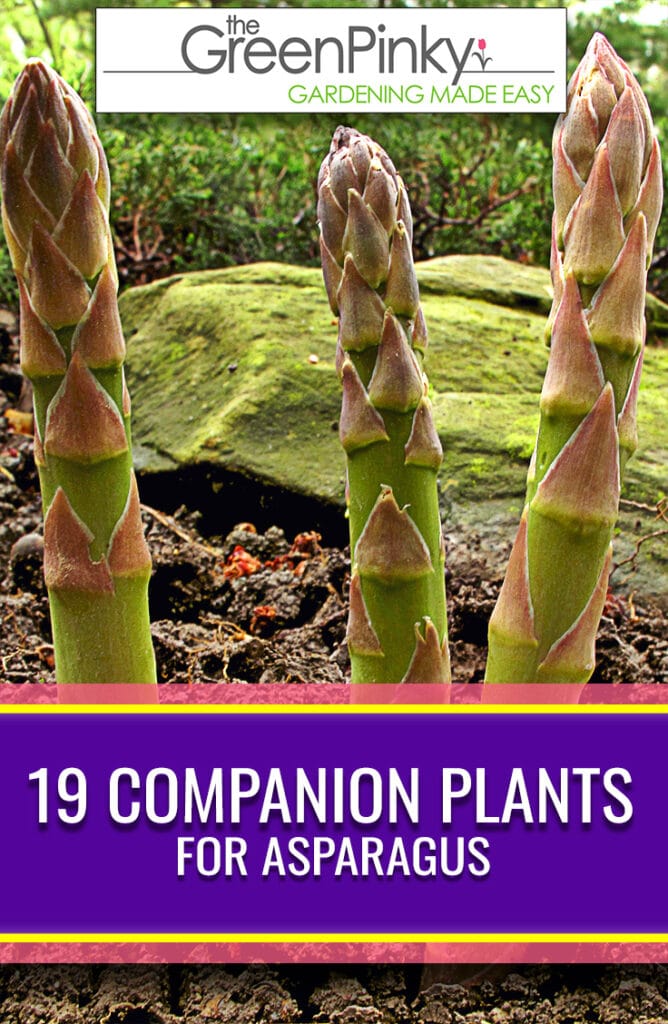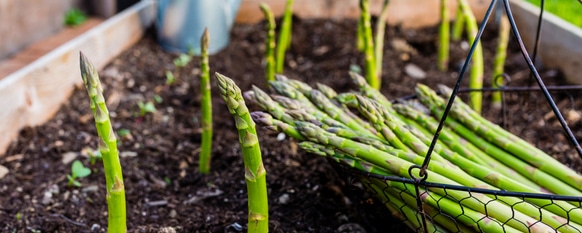Companion planting offers many benefits to gardeners, yet it is overlooked by some, especially those just getting started. Instead of haphazardly arranging plants in your garden, you should take the time to figure out which plants grow well together – a term known as companion planting in gardening. The practice isn’t difficult; it just adds a little time to planning.
When picking companion plants for asparagus, it’s essential to keep in mind the “partners” need to have similar growing requirements. Asparagus loves full sun locations and well-draining soil because too much moisture can rot the crowns. You’ll also need to remember that asparagus plants grow for 20 years, so they’re semi-permanent.
Make sure to check out our cilantro care guide to see how to grow cilantro as a companion plant. best of all, it is a herb that is used in many different dishes.

Benefits of Companion Planting
Companion planting is a gardening practice where specific plants are grouped to improve the health and growth of all included plants. These symbiotic relationships are often used as a natural method of minimizing garden pests or providing shade to cool-season crops. Some plants contain natural compounds that repel some garden insects, reducing the need for chemical applications.
Good Companions for Asparagus
Many plants work well in companion planting arrangements, giving gardeners diverse options to choose from when designing a garden layout. Herbs and vegetable plants are used most often in traditional gardens. Still, flowering ornamentals make a great addition with their bright bursts of color that help to draw in beneficial pollinators.
Herbs
1. Basil
Benefits: deters asparagus beetle, carrot fly, flies, mosquitos, whiteflies
Basil is excellent to put in your garden because of its easy-going nature. Aromatic compounds deter not only the pesky asparagus beetle but also flies and mosquitos, reducing the need for chemical pesticides. It grows best when it receives a minimum of 6 hours of sunlight daily and prefers consistently moist soil.

2. Cilantro
Benefits: deters aphids, Colorado potato beetle, spider mites
Cilantro is grown by most gardeners as an annual plant, enjoying the cooler seasons of spring and fall. Once air temperatures exceed 85°F, hormones within the plant trigger it to switch to reproductive mode, causing it to bolt. When grown as a companion plant, the tall fronds help to keep cilantro cooler and prevent bolting.
3. Comfrey
Benefits: deters asparagus beetle
Comfrey protects against fungal diseases and problems with rust. It also naturally attracts pollinators to the garden, increasing fertilization but also draws in beneficial parasitic wasps. The parasitic wasp Tetrastichus asparagi is the most important natural enemy of the asparagus beetle, feeding voraciously on the eggs before they can hatch and wreak havoc on your tender spears.

4. Dill
Benefits: deters aphids, spider mites, squash bugs
The natural aroma of dill plants helps to keep some of the peskiest garden insects at bay. Growing dill is straightforward, and their long taproots keep them from competing with asparagus for nutrients in the upper part of the soil. As temperatures climb in the summer, taller fronds cast shade and can keep dill from bolting.
5. Oregano
Benefits: deters cabbage moths
Oregano is popular in indoor and outdoor herb gardens with its extensive use in Mexican and Mediterranean dishes. It’s a bonus these perennial plants help to deter cabbage moths! Plants prefer well-drained soils and don’t want regular doses of fertilizer. Harvest oregano as you need, and the plant will grow fuller and bushier.

6. Parsley
Benefits: deters asparagus beetle
Parsley’s natural aroma acts as a natural pest repellent, yet it also encourages certain beneficial insects that prey upon harmful species. It’s typically grown as a biennial crop and prefers the cooler temperatures of spring and fall. Choose from either flat-leaf (18 to 24” tall) or curly (8 to 12” tall) parsley depending upon the height you’d like.
7. Sage
Benefits: deters bean beetles, cabbage moths, carrot fly
Garden sage is commonly grown in many herb plantings because of its culinary role. But its intense aroma and flavor naturally deter some garden pests. Like asparagus, sage prefers full sun locations and comes back year after year when cared for properly. Sage does like the soil to dry out a bit before watering.
8. Thyme
Benefits: deters cabbage moths, cabbage worms
Thyme is a low-growing evergreen plant, so it makes an excellent ground cover between the rows of crowns keeping weeds at bay. Regularly pinch the tops off of the plants and prune the woody stems to encourage full, bushy growth and plenty of heady aromatic leaves. The natural aroma will help keep bugs away.

Fruits & Vegetables
9. Eggplant
Benefits: deters asparagus beetle
Eggplants are one of the best companion plants to grow, keeping the devastating asparagus beetle from destroying your delicious spears. A member of the nightshade family, eggplant contains solanine, a toxic alkaloid known to be a highly effective biopesticide. Compact varieties are great choices if you garden in raised bed gardens or are limited by small spaces.
10. Horseradish
Benefits: deters aphids, blister beetles, caterpillars, Colorado potato beetles, whiteflies
Horseradish plants work exceptionally well to repel soft-bodied insects in the garden, protecting your prized spears. This excellent companion plant contains compounds, that when exuded, deter many bugs. Plants prefer moist, silty soils and grow well in either full sun or partial shade locations in the garden, so they grow contentedly alongside crowns.

11. Lettuce
Benefits: minimizes weeds between rows
Lettuce and asparagus work well as companion plants since asparagus provides the lettuce plants some much-needed shade during hot weather. In the summer, plant a crop of your favorite leaf lettuce between the rows of plants. Lettuce reduces weeds, and the tall fronds keep the soil temperature lower, helping keep lettuce from bolting and going to seed.
12. Peppers
Benefits: deters spiders, cabbage looper, spider mites
The capsaicin in peppers — the compound that gives the beauties their heat — acts as a natural repellent for many garden insects. Since plants are slower to grow and typically don’t get too tall, there is little concern they will shade out asparagus early in the season. Pepper plants also have great root systems, helping retain soil moisture.
13. Rhubarb
Benefits: repels aphids, caterpillars, beetles, thrips, whiteflies
Most gardeners know that their pets shouldn’t eat rhubarb leaves because they contain oxalic acid, a compound that is dangerous when ingested. But many don’t know this same compound is fantastic in repelling insects that munch on leaves. Just make sure you give rhubarb plenty of space to grow, so it doesn’t overcrowd neighboring plants.

14. Spinach
Benefits: minimizes weeds between rows
Another cool-season crop, just like lettuce, spinach loves growing with asparagus. Plant seeds between the rows of crowns in both the spring and the late summer. Spring crops will grow happily next to your spears, keeping weeds down, and later in the season, the asparagus fronds cast shade over the spinach to keep plants cooler.
15. Strawberry
Benefits: minimizes weeds between rows
Strawberries and asparagus are natural intercropping plants, making them an excellent pair for companion planting. They both begin growing early in the spring after the last frost. The root systems of the two species grow in different planes within the soil, reducing competition with the other for resources. Strawberries also help shade the soil and reduce weeds.

16. Tomato
Benefits: deters asparagus beetle
Not only are tomatoes a popular garden plant because of their fruits, but they also make a great companion plant with asparagus for pest control. The leaves are highly aromatic, helping to ward off nuisance bugs, and are one of the best natural repellants of asparagus beetles. Tomato root systems grow deep, too, so they don’t compete with crowns for nutrients.
Flowering Ornamentals
17. Asters
Benefits: deters most insects
Members of the aster family, including daisies, coneflowers, and sunflowers, are great companion plants as they naturally deter most insect pests. Asteraceae plants are typically problem-free regarding disease problems and grow in various conditions, needing little care from you. When in full bloom, the flower stalks make excellent cut flowers too.
18. Marigold
Benefits: deters most insects, including bean beetle, nematodes
Marigold plants, especially French marigold cultivars, deter most insect pests with their naturally pungent aroma, helping to cut down on both the flying and crawling critters in your garden. The plants also contain a phytotoxin that repels nematodes in the soil, making them especially helpful next to nematode-prone plants. In addition, they are thought to deter rabbits.

19. Nasturtium
Benefits: deters ants, bean beetle, squash bugs, striped pumpkin beetles; attracts hoverflies
Nasturtium plants work well with asparagus by deterring pests and helping to shade out weeds in the garden. The nasturtium plants also attract pollinators to improve yields and draw in hoverflies that prey on problematic insects like aphids. In addition, nasturtiums are easy to grow and work well in containers, raised beds, or in the garden bed itself.

